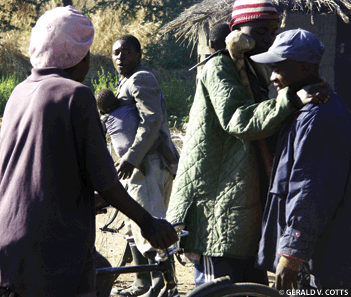
INTERNATIONAL RESEARCH | Dr. Susan Watkins, professor of sociology, is holding a meeting in a tent in Malawi, the small, landlocked nation in central Africa. She wears a T-shirt that says “Let’s Chat,” and her hair is pinned up Katharine Hepburn-casual. Her laptop screen glows at her side while her fingers tap out comments to questions with the speed of a court reporter, and her eyes never leave the face of the speaker.
Around her is a team of U.S. and Malawi graduate students who serve as supervisors of a program marshalling over 60 interviewers, nurses, and data clerks. They are comparing notes on the progress of a survey studying the responses of people in small rural villages to the AIDS epidemic.
Despite the seriousness of the situation and the dire predictions about the relentless spread of HIV, Watkins is an optimist. “Our research shows that people are taking charge of this pandemic themselves,” she says. “Even poor rural villagers know how HIV-AIDS is spread, know the consequences for themselves and their children, and are desperately trying to make changes in their lives to stop the rampage of the disease.”
The Penn study is led by Watkins and Dr. Hans-Peter Kohler, associate professor of sociology, and Dr. Jere Behrman, the William R. Kenan Jr. Professor of Economics and director of Penn’s Population Studies Center. They collaborate with researchers at the College of Medicine, University of Malawi, as well as colleagues from other universities. Financed largely by the National Institutes of Health, the study—which is conducted in rural areas, where most of the population lives—now covers 5,000 people, many of whom have been followed since 1998. In addition, the researchers learn what people are saying to their friends, relatives, and neighbors by using local “journalists” who keep diaries of conversations they overhear.
This summer the study offered counseling and testing for HIV to all respondents, making it one of the very few longitudinal studies to collect data on HIV infection.
“Much to our surprise, people were very eager to learn whether they were infected or not,” says Watkins. “The majority consented to being tested, and then came to get their results from trained nurses in little tents that we set up in the villages.”
Approximately 15 percent of adults between the ages of 15 and 50 are infected in Malawi, placing it sixth-highest in the macabre ranking. (Botswana is the unfortunate winner with a 35-percent infection rate.) HIV has already infected 1 million of the country’s 11 million inhabitants and kills 8,500 people every year, leaving thousands of widows, widowers, and orphans in its wake. Yet Watkins’ research and observations indicate that the image of Africans as fatalistic or in denial about the severity of the epidemic is not accurate.
“Villagers go to an average of four funerals a month,” she points out. “They have seen their friends and relatives wasting away with bouts of diarrhea, tuberculosis, and other opportunistic infections, and they know these mean AIDS. They are caring for the sick and for orphans, and profoundly worried that they themselves will die of AIDS, leaving their children behind.”
So it’s not surprising that people have come to be tested, and that the study’s data shows that they are prepared to change their behavior. “What our results show is, at least in Malawi, there is good reason to predict that the rate of new infections will decline,” says Watkins.
Getting a handle on the pace of the disease in the small, crowded country has been a challenge. Respondents first interviewed in 1998 were re-interviewed in 2001 and again in the summer of 2004, and will be contacted again next year. Though they are used to answering the questions in the 26-page interview, most live in remote huts, often several kilometers from the main road. In some cases they have changed their names, married, moved—or died.
Hence the small accompanying army of workers, including “scouts” hired from local communities to verify the location of previous respondents, and young local interviewers sporting the Let’s Chat T-shirts. The interviewers have completed high school and are fluent in the national language, Chichewa, as well as English and the mother-tongue of the three different regions.
The questions cover a broad range of human behavior and values—religion, spending habits, charity, family planning, and sexual mores.
“Religion, particularly evangelical churches, have called for lifestyle changes, reducing polygamy and increasing marital fidelity,” Watkins notes. “This, plus the lessons in schools and now an ‘engaged’ government with an active information campaign, have all contributed to slowing the spread of AIDS infection.”
This summer the team began testing for HIV and other sexually transmitted infections, in order to learn whether the behavior-change they think is happening will show up when they test again in 2006. Nurses who are part of the study team visit the respondents to get oral swabs for HIV as well as urine and vaginal swabs for gonorrhea, chlamydia, and trichomoniasis.
That, too, is no easy task: it requires travel by van, bicycle, or “footing it” to meet the correct respondent, explain the process, obtain consent, get the specimens, and carry them back to the survey base in small coolers. Along the way, the nurses are asked to look at a child with runny eyes, or to provide first aid from the kits they also carry. The specimens are driven to a laboratory in Lilongwe operated by the University of North Carolina.
When the results are ready, the nurses return to the village, setting up tents, announcing that the results are available, and treating those who test positive for sexually transmitted infections. Those who are positive or negative are counseled about their future, and the former are referred to the District Hospital, where the Government of Malawi, with funding from the United Nations’ Global Fund, is in the process of establishing testing centers around the country and providing antiretrovirals.
To add yet another dimension, the survey subjects have been expanded to nearly 2,000 adolescents, giving it more than 5,000 respondents. Global Positioning Satellite readings are used to identify huts with teenagers. Computers, rather than interviewers, are used to question some adolescents, the idea being that they just might tell the truth about sensitive subjects—such as whether they use condoms or have several sexual partners—if they have a degree of anonymity. The questions are asked through earphones, and the respondent taps out “Yes” or “No” on a keypad.
Since the researchers believe that Malawians have learned about AIDS through social interactions, the most effective means of dissemination may be through social networks (or, as Watkins calls them, “gossip circles”).
In these conversations, the topic of HIV-AIDS will come up, often in connection with the frequent funerals they attend, or with seeing someone who was once healthy become thinner and thinner.
“We find no reluctance to talk about AIDS—it is actually a major topic of conversation,” says Watkins. “Moreover, people are advising each other how to remain safe.”
Through diaries kept by local villagers, Watkins has been able to supplement the empirical data and learn what Malawians are saying to each other about the epidemic. Several villagers with high-school education have been asked to record, in hand-written journals, conversations related to HIV-AIDS that they have overheard or participated in. During her six years in Malawi, Watkins has worked with four or five of these “journalists,” whose accounts fill school composition booklets and are sent periodically to Watkins’ Philadelphia office.
“One never knows if answers to survey questions are all truthful,” she adds. “Just like we might say we watch only PBS television so that we seem more sophisticated, Malawi respondents might give answers they think sound better. The journals add a real dimension to our study.”
—Ann Garneau




